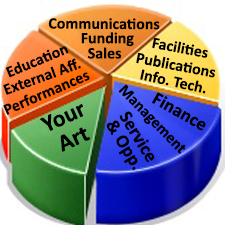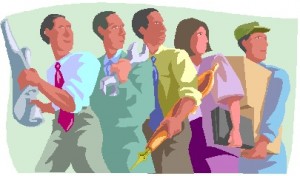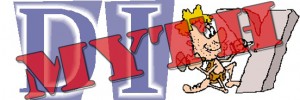For many years now the term DIY—Do It Yourself—has appeared in a variety of media: newspapers, magazines, books, cable television programs, web sites. The central concept is that even though you might not have the skills or experience, whatever it is that you want to do, you can learn to Do It Yourself with professional results.
There’s a lot of merit to the concept and there’s a lot of history to back up the approach. Up until the beginning of the 20th century, there were many places on the planet where people were proud to be able to do it themselves: farm, build a house, make furniture, and so on. In fact, there are still many places on the planet where people don’t depend on others for survival. They grow their own food, build their own dwellings, make their own clothes. They do it themselves.
Today, however, particularly in the western world, and parts of Asia, such as Japan and South Korea, community inter-dependency is a fact of life. An individual or family might have a small garden in the back of the house, but in urban areas people depend on one another for daily survival.
In the fine and performing arts, it is much the same, but still there is this pervasive notion that “Never mind, you’re not the Kennedy Center, or Lincoln Center, or famous like any number of artists (in any field) with high marquee value, you, too, can become successful if only you DIY, do it yourself!”
This concept, of course, is nonsense.
This past summer as a Baruch-Rubin Fellow at Baruch College (City University of New York), I had the opportunity to investigate the management structure of New York City arts institutions, in particular the Rubin Museum dedicated to Tibetan and Asian art and culture on West 17th Street. I came to a conclusion that should have been obvious from start: that whether you are large arts organization or a small to medium-sized one, the reality is you still need to fill certain functions, such as:
1. Top management, i.e., Executive Director (a.k.a. President), and directors/managers of various
enterprise functions
2. Finance & Administration
3. Services & Operations
4. External Affairs
5. Public Programs, e.g., performances
6. Director of Education, e.g., visitors programs, school liaison, et al
7. Communications, e.g., community relations, media relations
8. Funding, e.g., individual giving and major gifts, institutional giving, government funding,
membership dues
9. Facilities & Engineering
10. Information Technology
11. Publications, print/electronic information, new media
12. Merchandise for sale i.e., Shop@Rubin
 Think the above this doesn’t apply to the individual artist, regardless of art form? Think again. It all does.
Think the above this doesn’t apply to the individual artist, regardless of art form? Think again. It all does.
Top management: If you’re an individual artist or leader of a band, dance troupe, or art collective, someone has to lead. And that’s you!
Finance and administration: If you’re conducting your artistic career without much attention to finance and the administration of your income and expenses, you’re going to be broke real quick.
Services and Operations: What product or service do you offer your audience? If this is not well defined or you ignore the relationship between your talent and the potential audience, you won’t go very far.
External affairs: reaching out to audiences beyond your family, friends, and peer group is essential to growth. If you are not cultivating your audience, it won’t grow.
Public programs: Art that is unseen or unheard is art in a vacuum. Showing one’s artistic work (while willing to take the chance of failure—which always happens sooner or later) is necessary not only for individual growth but career growth as well.
Director of Education: Often (too often it seems) garnering an audience or convincing a key decision-maker to present your work is a matter of education. In my experience, the more successful artists are the ones who find every opportunity to teach.
Communications: This function is inherent to a couple of the abovementioned functions. The need to communicate with audiences and decision-makers is a constant.
Funding: There’s an old Negro spiritual that has the following line: “You can’t have romance without finance.” The same is true of artistic endeavors. You can’t have art without money. The truth is: “It’s always about the money.”
Facilities and Engineering: If you’re a dancer, you need a place to rehearse and choreograph. If you’re a musician, you need a place to practice or compose. If you’re in the fine arts, you need a place to create. Art does not happen in a physical vacuum. It happens in a physical space.
Information technology: Is there anyone out there who does not use information technology on some level?
Publications, print/electronic information, new media: This function refers to a couple of the abovementioned functions. Perhaps it’s a brochure, a pamphlet, a flyer, a poster, a postcard, a web site, Twitter, Facebook, Tumblr, email, et al. One way or another, anyone who has a view to success is using publications, print/electronic information, and so-called new media to advance their career.
Merchandise for sale: Think this doesn’t apply? Perhaps you’re purveying T-shirts with the band’s name on it, or giveaways with the dance troupe’s name on it, or balloons, or stickers, or selling physical CDs and/or downloads. Regardless, if you’re working to advance your artistic career, you’re selling something. Perhaps it’s not out of a brick and mortar store, perhaps it’s from your web site, but you’re selling something.
Now, the above has just made parallels between the organizational structure and functions of the Rubin Museum in New York City—a successful, well-funded, well managed organization with dozens of staff, from researchers and curators to performance programmers and public relations personnel—to the individual artist.
If you’re an individual artist attempting to gain career recognition and garner an income that goes well beyond a starvation diet, you, too, need to work at all the above functions. Is there any doubt that at the end of the day you’re exhausted? Of course you are. Creating your art and “getting it all together”—to steal a line from Sondheim’s Broadway show “Sunday in the Park With George”—is an effort that of necessity goes well beyond just doing it yourself (DIY).
There are many obvious differences between the world of the fine and performing arts of say 50-60 years ago and now. One of them is the urgent need for artists to be a lot more cognizant of the function of money, marketing, and public relations. In other words, today, and even more so into the future, an artist of any stripe or discipline, must deal with the reality of money and the many aspects of marketing and public relations. This is not to say, however, that artists need to actually do the marketing and public relations, but it does mean that artists understand the function, strategies and tactics of marketing and public relations.
Money aspects are especially important. Again, it does not mean that artists need to become accountants or financial planners, but it does mean artists need to educate themselves about budgeting, cashflow, and other numerous financial matters, for example, insurance. Innocence about these essential functions of life as an artist is no excuse.
 Last, rather than attempting to do it all yourself, the artist needs to find people who can perform the functions that are beyond the artists’ acumen, experience, or temperament. Some artists are very good with money. Many are not. My experience has been that most artists don’t want to deal with money matters, as if touching this world will be harmful to their artistic health. Fact is, the reverse is true. If artists don’t deal with money matters, it will deal with them.
Last, rather than attempting to do it all yourself, the artist needs to find people who can perform the functions that are beyond the artists’ acumen, experience, or temperament. Some artists are very good with money. Many are not. My experience has been that most artists don’t want to deal with money matters, as if touching this world will be harmful to their artistic health. Fact is, the reverse is true. If artists don’t deal with money matters, it will deal with them.
The question then becomes: where do you find people to fulfill all the functions of an individual artistic endeavor? Consider this: the last four years have been harmful to the financial health of many in this country. There’s now a new normal. It has dawned on many to lower financial expectations—especially small, independent companies in the various fields mentioned above. This creates an excellent opportunity for the individual artist in that many of the various experts you need to partner with are willing to take on new clients at a reduced fee or perhaps are open to a barter, or some combination of the two.
Every artist really needs a small army to move the artistic endeavor along. If the artist is more educated as what needs to get done and when it needs to get done, finding the personnel to fill the several management functions defined above will be an easier task. First, though, the artist needs to educate himself or herself as to what is required.
There is a saying in education that applies widely: “When the student is ready, the teacher appears.” There’s another saying, also from the world of education: “It takes a village to raise a child.” When the individual artist goes to the trouble to educate himself or herself to what is required to manage the artistic endeavor, the people will appear and DIY will no longer be such a formidable approach. The resources are out there.
More on this topic in future blogs.
Please write to me at meiienterprises@aol.com if you have any comments on this or any other of my blogs.
Eugene Marlow, Ph.D.
December 3, 2012
© Eugene Marlow 2012


